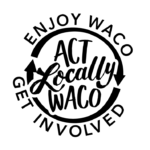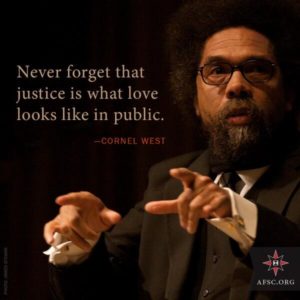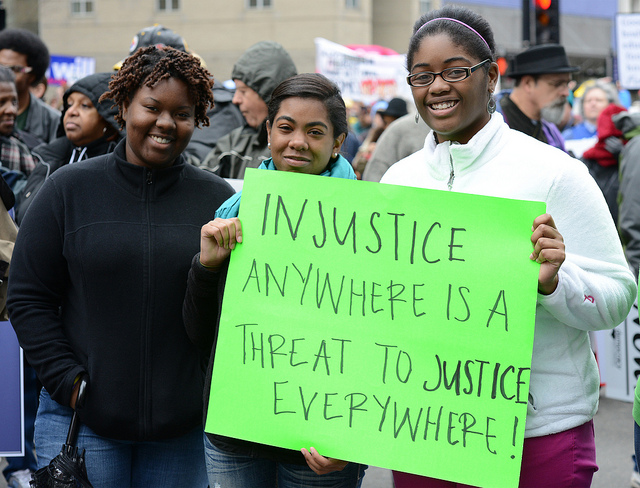By Stephanie Korteweg
 Do you remember your childhood the way I remember mine?
Do you remember your childhood the way I remember mine?
Water gun fights, hot summer days, swimming pools, imagining that you somehow, by some miraculous event, can run faster than the day before. Clenched teeth, you muster up every ounce of your energy to run with this newfound supernatural strength. You run so hard that your body feels like at any moment you could come teetering down, but in sheer delight you are convinced that the next time you can run a little faster still.
I remember as a child I wanted to be a super hero. At the ripe age of three I was convinced that I could fly. Why not? I had seen plenty of super hero with capes flying on TV. They looked just like me, sans the fact that they were another gender or at least 20 years my elder- duh, they were human, and as luck would have it so was I!
So one day in my Wonder Woman PJ’s I decided to put my flying skills to the test. I climbed up on the couch, and with a half-hearted jump I landed on the ground – unhurt and undeterred. I needed to go all out if I was going to put my super powers to the test. Hands out- just like in the movies. It needed to be done. I needed to show the world human flight was possible. So this time, I decided I needed to get on the highest point of the couch, the arm rest, and jump from there.
I didn’t need to be a wimp about it anymore, it was all or nothing, baby. I was in! I was airborne- for a millisecond. The next second, is when my face made contact with the coffee table. It was then I decided to put my flying ventures to rest, at least for a while. My mom said, “Steph, you can’t fly-even though you saw it on TV, that’s make believe. You can do other things, but flying is not something you can do.” Feeling a bit disappointed, and a little silly, I had to make an early visit to the dentist.
 Fast Forward ten years and my dad had several rental properties that he would rent out to older widows. Every weekend we would load up the lawnmower and head out to these properties. I coveted the time with my dad, working together on the yard. It was hot, dusty and dirty, and I didn’t really like cutting lawns, but I do love time with my dad! Every time we would finish, my dad would MAKE us go and talk to the older ladies. We would always bring them lunch, and sit and talk to them. This was NOT my favorite part. I would ask my dad, “Why do I have to sit and talk with them? I don’t even know them. And why do we always bring them a meal?”
Fast Forward ten years and my dad had several rental properties that he would rent out to older widows. Every weekend we would load up the lawnmower and head out to these properties. I coveted the time with my dad, working together on the yard. It was hot, dusty and dirty, and I didn’t really like cutting lawns, but I do love time with my dad! Every time we would finish, my dad would MAKE us go and talk to the older ladies. We would always bring them lunch, and sit and talk to them. This was NOT my favorite part. I would ask my dad, “Why do I have to sit and talk with them? I don’t even know them. And why do we always bring them a meal?”
My dad, explained that these women don’t have any family nearby and they enjoyed talking to me. It was the least I could do – no excuses. I needed to sit with them, even if it was just enjoyable to them, because they had no one else.
Looking back on my life lived – having traveled to over 15 countries I see the same wonderment, joy and vitality in the children around the world. That thirst for what is possible. The question of what can I do? The need for guidance and safety in the boundaries, “no you can’t fly, but you can do other things.”
At the bottom of every basic human need is the need for connection. Taking time to sit and talk with someone else. Someone you wouldn’t normally talk to. Not for their good, but for yours. You see I learned something, when you take time to talk to someone, you place value on them. I am marked. I am convinced. People are worth it. Little or big, everyone needs someone.
 January is National Mentoring Month. There are about 15,000 students in WISD, and most of them need a champion. Someone who will sit and talk to them. There are lots of ways to get involved. Do it! If you have 30 minutes once a week- there is a place for you!
January is National Mentoring Month. There are about 15,000 students in WISD, and most of them need a champion. Someone who will sit and talk to them. There are lots of ways to get involved. Do it! If you have 30 minutes once a week- there is a place for you!
The beneficial effects of mentoring are well documented. The mentoring organizations in Waco have gathered together because we see the need for connection, guidance, and mentoring. Want to get involved? I’d love to hear from you! Go place value on a kid! You might just even find yourself enjoying it.
Resources for learning about mentoring in Waco:
Contact info for Stephanie: [email protected]
 Stephanie Korteweg is the Director of the STARS Mentoring Project at Antioch Community Church. She is happily married to Jeremy Korteweg. She graduated Baylor and taught in WISD for 12 years before becoming the Director of STARS. She and her husband love to travel and do anything outdoors. Their love for God is what compels them to serve others. She is committed to placing value on children and contributing to the betterment of the city.
Stephanie Korteweg is the Director of the STARS Mentoring Project at Antioch Community Church. She is happily married to Jeremy Korteweg. She graduated Baylor and taught in WISD for 12 years before becoming the Director of STARS. She and her husband love to travel and do anything outdoors. Their love for God is what compels them to serve others. She is committed to placing value on children and contributing to the betterment of the city.
by Ashley Bean Thornton
These are exciting times in Waco! Let’s keep that ball rolling with some community-centric resolutions for 2015. Here are a few ideas to get us started. I’m sure you can think of many others…
Spend more time downtown – So much great stuff is happening downtown! The more we take advantage of the opportunities, the better they will become. If you haven’t been downtown lately, “First Friday Waco” (find it on Facebook) is a good way to stick a toe in – lots of downtown shops and other places stay open late the First Friday of each month. Or check out the scene at the Waco Downtown Farmer’s market. I don’t even like vegetables (maybe a resolution for next year!), but I love going to the farmer’s market and watching the parade of dogs and babies. If you don’t want to spend much (or any) money, there are lots of free activities downtown throughout the year: Brazos Nights Concert Series, Fourth of July Fireworks, Waco Cultural Arts Fest, Waco Wonderland, Baylor Gameday, and the biggest free gift of all – Cameron Park. Check out www.chisholmcrossing.com to get the details about downtown happenings.
Spread good news about Waco ISD – Whether we have school age children or not, every single one of us has a stake in Waco ISD. A thriving public school system is a “must have” for Waco to achieve its potential as a terrific community. Resolve to be a cheerleader for our school system. Google “Waco ISD enews” to find the website where you can sign up for the Waco ISD “In the Know” newsletter. It comes out a couple of times a month and is full of examples of great things happening in our local schools. It will make you proud of what our students and educators are doing, and it will give you plenty of good news to spread. If you want to get even more involved, google “WISD Community Partnerships” to find information about volunteering, or participating in the Adopt-A-School program. You can also find wish lists from various schools in the district on that same site .
Use social media as a force for good – I love Facebook. I love seeing pictures of my friends’ at play. I’ll even admit to enjoying the occasional cat video or “dog shaming” slideshow. Our devotion to Facebook, Twitter and other social media can be a boon for our local non-profits. These media provide an inexpensive way to get the word out about events and services. They can be extremely effective channels of communication especially if we will all help by sharing and retweeting. Most of the non-profits in town have Facebook pages and/or Twitter accounts. “Like” or “follow” your favorite organization. When you see something intriguing from them in your newsfeed, resolve to share it. Of course I have to mention the Act Locally Waco Facebook account/Twitter feed. It’s a great way to keep up to date on all kinds of neat things going on that make our community a great place to live. When you see something you like, share it!
Reach across a line that divides us – Waco is a beautifully diverse community. There are lots of opportunities for us to work together, play together, worship together, and get to know each other. Make a special effort this year to learn more about what it’s like to be a part of a race, ethnicity, religion, sexual orientation or income level different from your own. Go to a meeting of the Community Race Relations Coalition, the Waco Interfaith Conference , or Waco Interweave. Worship at Church Under the Bridge or visit another place of worship that is very different from your own. Read something or watch a documentary about people who have a different point of view from your own. I’ll go out on a limb here and say this is especially important if, like me, you identify as a member of the White, straight, Christian, middle-class. It is the path of least resistance for those of us in the majority to stay cocooned in our own majority culture. Resolve this year to make the effort to at least begin to break out of the cocoon. We don’t have to agree with or like everything we see in the world outside of our comfort zone, but we will all be richer for the increased understanding.
Advocate for Arts in Waco – I’ve never thought of myself as a particularly “artsy” person. I used to think of the arts as a “frill,” something to give us a little break from wrestling with the “important” issues of jobs, health, and education. Now I understand more clearly that the arts are how we nurture the hope, strength, understanding, honesty and wisdom to be able to work together to chip away at these complicated challenges. Participation in the arts builds passion, compassion, insight, creativity, confidence and discipline. Arts programs in our schools, The Waco Arts Initiative , The Waco Cultural Arts Festival, Mission Waco’s Jubilee Theatre and Urban Expressions program, Nuestra Voz at the Art Forum of Waco, Art on Elm, Miriam’s Army Girl’s Dance Troop at Restoration Haven, The Word Gallery, Teen Speak Out… these are just a few examples of arts initiatives that are strengthening the roots of our community. So, make your own art. Support a program that makes the space for others to participate in the arts. Or, resolve to enjoy seeing more art. Make this the year you get involved with the arts in Waco.
I have learned through the years that if I set too many goals, the chance that I will do ANY of them decreases dramatically. I’ll be keeping my list short this year, maybe even just one or two resolutions. We don’t all have to do everything. Even if each of us just makes one “Waco-centric” resolution, and sticks with it, we will be a stronger community a year from now. What will yours be? Happy New Year, Waco! Here we go!
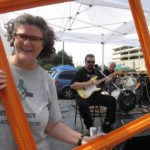 This Act Locally Waco blog post is by Ashley Bean Thornton, the Manager of the www.www.actlocallywaco.org website and the editor of the Friday Update newsletter. The Act Locally Waco blog publishes posts with a connection to these aspirations for Waco. If you are interested in writing for the Act Locally Waco Blog, please email [email protected] for more information.
This Act Locally Waco blog post is by Ashley Bean Thornton, the Manager of the www.www.actlocallywaco.org website and the editor of the Friday Update newsletter. The Act Locally Waco blog publishes posts with a connection to these aspirations for Waco. If you are interested in writing for the Act Locally Waco Blog, please email [email protected] for more information.
“We are more alike, my friends, than we are unalike” –Maya Angelou
by Amber Jekot
In a city of residents dedicated to addressing poverty and hunger, in a city with nonprofits aplenty, in a city where zeal for addressing these concerns is even a part of our city’s governance, we find ourselves proud of this strange gem of a place – Waco, Texas. While our pride is justified, we must also admit the broken reality that dividing lines between neighborhoods, races, and socioeconomic classes linger despite our well-intentioned attempts to address them.
Perhaps part of the reason these divisions persist is the language we use and the story we tell about our community.
The language we use forms our reality. A recent study by Feeding Wisconsin found that the way we speak about hunger dictates how people respond – or do not respond – to this challenge. The study suggests that by utilizing shocking statistics, by telling the most devastating story we can conjure about those in poverty, and by neglecting to tell the success stories of our community, anti-hunger advocates actually do more harm than good for the cause of change – by unintentionally making hungry people seem “different.”
A distance between people is created when the pitiable reality of hunger conflicts with the universally held value that no human should have to experience hunger. This value is especially strong in America, the wealthiest country in the world, where, though the reality of hunger “should” no longer exist, 1 in 5 Americans are food insecure. The Feeding Wisconsin study found that when one’s values conflict strongly with reality, blame surfaces. In this case it is blame of the hungry people: “there must be something wrong with them for hunger to occur here.” With this in mind, maybe the story we tell about our community needs to be reoriented. Perhaps linguistic alterations can help break down barriers between “us” and “them.”
 John Steinbeck, author of the classic The Grapes of Wrath, shows us the faces of hunger in a way that breaks down the barriers between seemingly disparate groups of people. The reader is drawn into the epic journey of a struggling, yet inspiringly resilient family who experiences hunger as a result of the 1930’s dust bowl. The reader is invited into a distinctively unfamiliar reality, yet becomes an ally of the protagonist, the Joad family unit, by developing a deep knowing and understanding. The storyteller invites us into an authentic relationship that bridges the distance between “them” and “us.”
John Steinbeck, author of the classic The Grapes of Wrath, shows us the faces of hunger in a way that breaks down the barriers between seemingly disparate groups of people. The reader is drawn into the epic journey of a struggling, yet inspiringly resilient family who experiences hunger as a result of the 1930’s dust bowl. The reader is invited into a distinctively unfamiliar reality, yet becomes an ally of the protagonist, the Joad family unit, by developing a deep knowing and understanding. The storyteller invites us into an authentic relationship that bridges the distance between “them” and “us.”
Steinbeck’s mantra throughout the book cautions the reader to be wary of confusing effects with causes: “These things are results, not causes. Results; not causes; results, not causes” (Steinbeck, p. 152). The hungry in Steinbeck’s novel and the hungry in the Feeding Wisconsin study are subject to the same common mis-assignment of cause. We don’t believe people should be hungry, yet people are hungry. This harsh reality rubs painfully against the grain of our values. So, to reduce the pain we come to believe that hungry people must be different from us. They must be the cause of their own plight. We need to question this assumption about cause with more depth.
For example, individuals who are having a difficult time paying for food are often blamed for making unwise financial decisions. They are criticized, for example, for purchasing simple pleasures when they could be saving up for rent. If we consider this criticism through the lens of the idea that we are all more alike than we are different, we can begin to recognize that spending beyond our means is an American problem, not just a problem for the poor. As a graduate student, I can attest to this. My fellow students and I sip our overpriced caffeine fixes while at the same time complaining about loans we’ll be paying back for the next fifteen years. The mortgage crisis that played a fundamental role in our country’s economic downturn was partially caused by middle class individuals spending beyond their means. Banks even participated in this irresponsible spending behavior by offering subprime loans.
College students, bankers, homeowners, and those who are struggling to buy the healthy food they need are far more alike than we are different. The difference between these groups of people is not just that one group is financially responsible while the other is irresponsible. We all make financially irresponsible decisions. At least part of the difference is that systems in place make it easier for some groups to recover from their irresponsibility while making it likely that others will fall farther behind. Paying back a payday loan, paying back credit card debt, and having the government help out a financial institution, are very different support systems with very different consequences.
The Feeding Wisconsin study found that for folks to recognize and acknowledge the whole range of causes of hunger, we must tell the story in a way that acknowledges that we’re all really more alike than we are different. The desire for financial security and breathing room within one’s budget, the need for someone to help us out every once in awhile, and the goal of striving towards a better life are universal values and needs, not just values and needs of a particular group of people. Narratives like Steinbeck’s Grapes of Wrath help to give faces of strength to those who need a little help and those who, in actuality, are much more like us than they are different. Just as Steinbeck narrates a story that bridges the gap between the “us” and “them,” so can we.
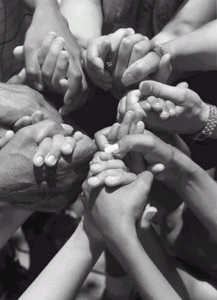 Stories of strength and resiliency of those who experience hunger are widespread in our city: the single mom who, never having maintained a living wage, is now taking night classes because she wants her children to have more opportunities than she ever had; the man who works 70 hour weeks just to give away his money to those in need because “he knows what the struggle is like;” the woman who skips a day of work to advocate for her child’s education and makes concessions to her own health on behalf of her family. These stories represent individuals who — not too unlike those who are well fed — have hopes and dreams for themselves and their families. They just need some support as they move towards their respective goals.
Stories of strength and resiliency of those who experience hunger are widespread in our city: the single mom who, never having maintained a living wage, is now taking night classes because she wants her children to have more opportunities than she ever had; the man who works 70 hour weeks just to give away his money to those in need because “he knows what the struggle is like;” the woman who skips a day of work to advocate for her child’s education and makes concessions to her own health on behalf of her family. These stories represent individuals who — not too unlike those who are well fed — have hopes and dreams for themselves and their families. They just need some support as they move towards their respective goals.
Our city exudes resiliency, strength, and potential. Let us breathe life into our community narrative and believe the best about our neighbors. Waco, join me in working to engage more with people who upon first glance seem different. Let’s tell a better story.
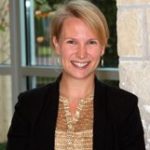 Today’s Act Locally Waco blog post is by Amber Jekot. Amber is an 8-year Waco resident who works as a graduate assistant at the Texas Hunger Initiative. She is finishing a masters of social work at Baylor University and a masters of divinity at Truett Seminary. She is passionate about the intersection between food, justice, and community and has been known to take trains without knowing her destination. You may contact her via email at [email protected].
Today’s Act Locally Waco blog post is by Amber Jekot. Amber is an 8-year Waco resident who works as a graduate assistant at the Texas Hunger Initiative. She is finishing a masters of social work at Baylor University and a masters of divinity at Truett Seminary. She is passionate about the intersection between food, justice, and community and has been known to take trains without knowing her destination. You may contact her via email at [email protected].
The Act Locally Waco blog publishes posts with a connection to these aspirations for Waco. If you are interested in writing for the Act Locally Waco Blog, please email [email protected] for more information.
Sources used in this post
Feeding Wisconsin (2014). Reframing hunger in America. Research presented at the Texas Hunger Initiative Together at the Table Hunger Summit.
For access to the presentation: https://baylor.app.box.com/s/xykec2gcq9s5m70i0obi/1/2601980659/22198738747/1
RTI Intl, Center for Health & Environ Modeling (Jul 2014). Current and prospective scope of hunger and food security in America: A review of current research. Research Triangle Park, NC: RTI International.
For the full report visit: http://www.rti.org/publications/abstract.cfm?pubid=22989
Steinbeck, J. (2006, 1939). The Grapes of Wrath. Penguin classics. New York: Penguin Books.
by Stephanie Drum
The winter season is often a time of celebration and frequent get-togethers with friends, family, and coworkers. Unfortunately, according to the Council on Drug Abuse, the holiday season also sees a significant and reoccurring spike in depression, suicide, domestic violence, and drug and alcohol abuse – often intertwined. Especially for those who struggle with substance use and abuse, the holidays can be a time where they seek to cope with stress and may even relapse.
Self-awareness is important during a season often marked by liberal amounts of alcohol. The National Institute on Alcohol Abuse and Alcoholism (NIAAA) and the National Highway Traffic Safety Administration (NHTSA) report that 2-3 times more people die in alcohol-related crashes during Christmas and New Year’s than at other times of the year. They also report that 40% of drivers involved in traffic accidents during the holidays are impaired by alcohol. Adults should remember to drink moderately and responsibly if they do choose to partake, not only for their own well-being but also for others.
This is especially true where children are present. As coordinator for the VASA (Voices Against Substance Abuse) Community Coalition Partnership, I have found that of those surveyed in McLennan County, underage youth most often get alcohol from older adults or social venues such as house parties. Many adults believe there is no danger in underage consumption of alcohol with the proper supervision. However, in addition to the severe legal consequences of providing alcohol to minors ($4000 fine and up to a year in jail), youth who consume alcohol are far more likely to frequently binge drink (defined as 5+ drinks for males and 4+ drinks for females in one sitting) as well as get into traffic crashes (NHTSA).
Furthermore, while underage youth are out of school for the winter, temptation is strong for participating in recreational alcohol or drug use, sometimes simply out of boredom. The VASA Community Coalition encourages you to remember how influential you are in the lives of youth and that you can positively affect the decisions youth make.
You can make your voice known in the following ways:
- Speak with your child about alcohol and drugs, and make sure they know you do not approve.
- Do not provide alcohol or drugs to minors, or have them easily accessible.
- Be well-informed about parties or other events your child attends.
- Be conscious and careful if you choose to partake as an adult.
The holiday season should be full of joy and celebration. Let’s all work together to make this one safe, fun, and joyful! To receive more information please visit our Facebook/Twitter pages, or email me at [email protected].
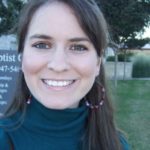 Stephanie Drum is the VASA Community Coalition Coordinator and works at VOICE. She has a Bachelor of Arts from the University of Mary Hardin-Baylor and a MDiv/MSW from Truett Seminary and Baylor University. She loves baking, the country and all kinds of art. Please contact her at [email protected] or (254) 741-9222 – she would love to share more about VASA Community Coalition!
Stephanie Drum is the VASA Community Coalition Coordinator and works at VOICE. She has a Bachelor of Arts from the University of Mary Hardin-Baylor and a MDiv/MSW from Truett Seminary and Baylor University. She loves baking, the country and all kinds of art. Please contact her at [email protected] or (254) 741-9222 – she would love to share more about VASA Community Coalition!
The Act Locally Waco blog publishes posts with a connection to these aspirations for Waco. If you are interested in writing for the Act Locally Waco Blog, please email [email protected] for more information.
By Matt Hess
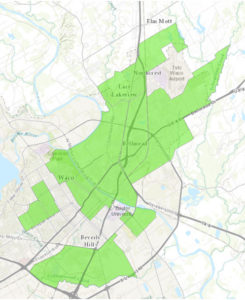
The areas marked green have low income and low access to food according to the USDA Food Access Research Atlas.
Have you ever thought about how difficult it is to get nutritious food if you don’t have a car? The USDA defines a “food desert” as a geographic area where affordable and nutritious food is difficult to obtain, particularly for those without access to an automobile. Research links food deserts to diet-related health problems like diabetes, obesity and heart disease. 57,983 people in Waco live in USDA-declared “Food Desert” tracts; that is 46.5% of our total population. This issue received quite a bit of attention recently when two HEB stores merged into one and a third HEB closed its doors – creating even greater distances between affordable, healthy food and some of the people who need it. Unfortunately, it seems like many of the areas where people most need access to fresh fruits and vegetables are not the most practical, from a business point of view, for a food retailer to set up shop.
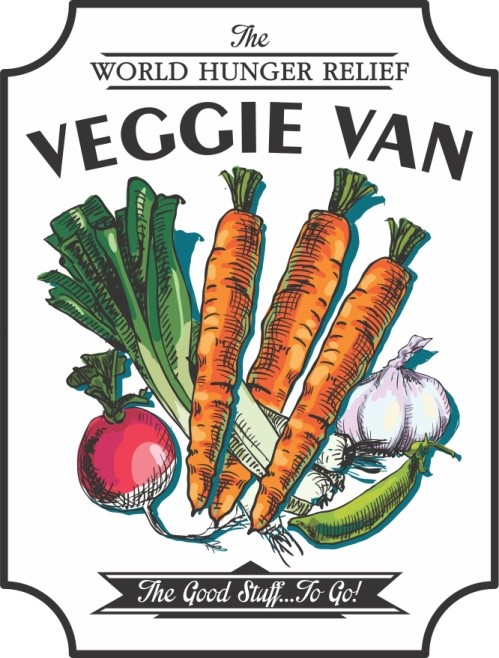 With all that in mind, World Hunger Relief, Inc. (WHRI) is launching a new program called the “Veggie Van.” The Veggie Van, a mobile vegetable stand, will allow us to sell vegetables for short periods of time when large crowds gather, i.e. at the end of the school day or after a church service. This will allow us to keep our costs low while providing vegetables in a way that is convenient to families.
With all that in mind, World Hunger Relief, Inc. (WHRI) is launching a new program called the “Veggie Van.” The Veggie Van, a mobile vegetable stand, will allow us to sell vegetables for short periods of time when large crowds gather, i.e. at the end of the school day or after a church service. This will allow us to keep our costs low while providing vegetables in a way that is convenient to families.
The Veggie Van idea is the result of study, careful thought, conversation, experimentation and collaboration around the subject of nutrition in Waco. In the last several years there have been numerous assessments and community input meetings conducted about this issue. The WHRI staff and I attended as many of these meetings as possible.
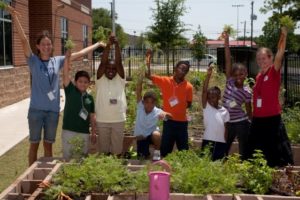 Ten years ago WHRI completed an assessment of food issues in our area. This assessment led us to pursue school gardening as a way to address a need expressed by the community and to develop relationships for future efforts at improving the nutrition of those in Waco. School gardens are still an important part of our strategy, this year there are 5 schools that are visited weekly by our interns. In these programs I have seen students eagerly trying new vegetables as they develop skills in gardening and food production. As students’ interest in healthy eating increased, we became more aware of food deserts in our community. We encourage students to eat healthily but the environment in their neighborhoods and lack of access to fresh produce makes it difficult for their families to change their eating habits.
Ten years ago WHRI completed an assessment of food issues in our area. This assessment led us to pursue school gardening as a way to address a need expressed by the community and to develop relationships for future efforts at improving the nutrition of those in Waco. School gardens are still an important part of our strategy, this year there are 5 schools that are visited weekly by our interns. In these programs I have seen students eagerly trying new vegetables as they develop skills in gardening and food production. As students’ interest in healthy eating increased, we became more aware of food deserts in our community. We encourage students to eat healthily but the environment in their neighborhoods and lack of access to fresh produce makes it difficult for their families to change their eating habits.
 Through the Act Locally Waco book club I read the book Switch by Chip and Dan Heath. My short synopsis of the book is that to make personal or group changes three things need to be in place: (1) knowledge of why the change needs to be made, (2) motivation to change, and (3) an environment that allows for this change. Our work with the school garden clubs touches on the first two — we have seen an increase in knowledge and motivation about eating healthy foods. We are also working with many partners who provide education about good nutrition, cooking skills and how to stretch food dollars. Building an environment that allows for change is more challenging, we think the Veggie Van will be a good way to begin to address that issue.
Through the Act Locally Waco book club I read the book Switch by Chip and Dan Heath. My short synopsis of the book is that to make personal or group changes three things need to be in place: (1) knowledge of why the change needs to be made, (2) motivation to change, and (3) an environment that allows for this change. Our work with the school garden clubs touches on the first two — we have seen an increase in knowledge and motivation about eating healthy foods. We are also working with many partners who provide education about good nutrition, cooking skills and how to stretch food dollars. Building an environment that allows for change is more challenging, we think the Veggie Van will be a good way to begin to address that issue.
Starting, January 14, 2015, the Veggie Van will be selling vegetables with the congregation of St. Luke AME church on the corner of Elm St. at Church St. near the Paul Quinn Campus. At WHRI we hold tightly to the value of working with and supporting other organizations. One of the most exciting things about the Veggie Van is that it will let us add value to work St. Luke and other churches and organizations are already doing in Waco. St. Luke has a great proactive food ministry including a community garden and an outreach program that helps people sign up for SNAP benefits (food stamps) right at the church. The Veggie Van will be a natural supplement to these existing programs. As we look for other locations we are hoping to work with other organizations who are already doing good work in the area of food and nutrition.
We would love to include you in our holistic food ministry. I hope you come and visit us at the van and pick up some great locally grown food for your family. We will be looking for volunteers to help on the van and to help spread the word throughout the community. If you are interested in helping, or if you are just curious, give us a call (254-799-5611), drop us an e-mail ([email protected]) or come see us at one of these opening week events:
- January 14th – 3:00 PM – the Veggie Van opens for business for the first time at St. Luke AME.
- January 14th – 6:00 PM – the Veggie Van blessing ceremony at St. Luke AME.
- January 17th – 11:00 AM – ribbon cutting at the Waco Downtown Farmers Market.
- January 19th – 11:00-2:00 – The van will visit all of the gardens participating in the MLK Day Day of service the around Waco. We will have more details on our Facebook soon.
 For more information about the Veggie Van Project and how you can get involved, please take a moment to visit the website: worldhungerrelief.org/veggie-van, or follow us on social media (Facebook: facebook.com/whriwaco. Twitter:@whriwaco). If you are interested in hosting the van at your church, organization, or other location please fill out the application here. If you would like to contribute financially, we would sure appreciate it. Here’s the link: Donate.
For more information about the Veggie Van Project and how you can get involved, please take a moment to visit the website: worldhungerrelief.org/veggie-van, or follow us on social media (Facebook: facebook.com/whriwaco. Twitter:@whriwaco). If you are interested in hosting the van at your church, organization, or other location please fill out the application here. If you would like to contribute financially, we would sure appreciate it. Here’s the link: Donate.
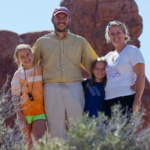 Today’s Act Locally Waco blog post was written by Matt Hess. Matt grew up in Boulder, CO. He came to Waco to attend Baylor where he received a Bachelors of Science in Education in History. Afterwards, he stayed in Waco and taught at a school for troubled youth. As a teacher, he saw the difference that working with animals and gardens made on his students, and he began volunteering at WHRI partially with the intention of developing more skills in agriculture and community development. Matt joined WHRI as the Education Director in 2006 years and 6 years later transitioned to his role as Executive Director.
Today’s Act Locally Waco blog post was written by Matt Hess. Matt grew up in Boulder, CO. He came to Waco to attend Baylor where he received a Bachelors of Science in Education in History. Afterwards, he stayed in Waco and taught at a school for troubled youth. As a teacher, he saw the difference that working with animals and gardens made on his students, and he began volunteering at WHRI partially with the intention of developing more skills in agriculture and community development. Matt joined WHRI as the Education Director in 2006 years and 6 years later transitioned to his role as Executive Director.
The Act Locally Waco blog publishes posts with a connection to these aspirations for Waco. If you are interested in writing for the Act Locally Waco Blog, please email [email protected] for more information.
By Jenuine Poetess
Recently I was asked a series of questions all circling around this central notion of, Why poetry? Why art? What purpose does it serve society? Below I share my reflections as I have experienced them. As art is a universal experience with each person giving and receiving into that experience from their own particular filters, there are countless ways to engage these questions. My thoughts are by no means the only ones; please, in the comments, join the dialogue.
Across all of time, art has served as a platform from which to launch ideas, movements, tectonic shifts in collective consciousness.
Personally, I write, I create, because I must. Poetry is my pulse. My breath. A truth that must be written, spilled onto pages between tears, between swoons, between heart-racing becoming. Because I cannot stay quiet.
I write to know myself. I write in protest of injustice—both personal and global. I write to heal. I write to remain compassionate and conscious. I share to remember I am not alone and in doing so, give others permission to be exactly who they are, without shame. I share to bear witness to my stories, to grow with others, to build community, and to forge relationships.
Publicly, poetry—and all art really —is a catalyst. For healing. For change. For protest. For validation. For transformation. Art holds space for what must be said. Art invites sensual experience; and opportunity to feel with another. Art has the potential to condense moments, events, truth into a universally accessible dialogue.
Regarding poetry particularly, I see it making a return to the esteem it once held in past societies. It has a long way to go. There are a myriad of iterations to poetry—from the academic and technically sharp to the raw, provocative spoken-word; from the beauty of strict form to the wilds of free-verse flows all of it serves the artistry of poetry.
On Sunday November 30th, Waco Poets Society and In the Words of Womyn—two local, grass-roots programs—held an open mic and sharing circle in solidarity with Ferguson and to hold space for dialogue about the systemic issues of racism, especially regarding the experience of Black persons of color in the US, and police brutality. We held this space so that we could give sound to our story and volume to our voice. Because in an open mic circle, all people have authority to speak their truth. The circle is a neutral gathering space for dialogue, for grieving, for thrashing out pain, meaning, and transformation.
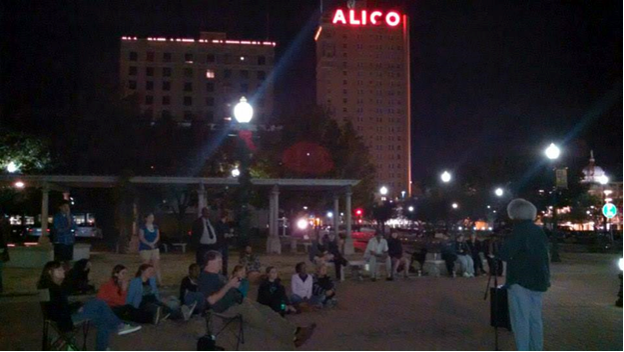
Over 40 people from across the community gathered to share poems, songs, reflections, and prayers continuing a national dialogue on justice, racism, and hope for healing. Pictured here, community activist, Bettie V. Beard speaking.
i poem
i create
i gather with others
sharing
thinking
speaking
wailing
trembling
organizing
aching
shouting
loving
for change
for justice
for sustained thriving
because it is the only way i know how
to navigate
this broken world
to counteract
the hate
to understand
how to keep going
to remember
why we do this work
so that every time
i look into the curious eyes
of the next generation
i know i have done
my part
even if in vain
to know that i have been diligent
to fight
with everything in me
to make it safe
for them to be
to play
to walk
to breathe
to dance
to speak
to rage
to become
to live
As I am working, with intention, my way out of blindness to my white privilege, I remember how my community has and continues to guide and love me into consciousness with fierce truth and relentless compassion.
I don’t have all the answers for how to fix or even reconstruct our system—nationally and within our community. It is not my responsibility to have them all or come up with them. It is my job to recognize what is broken, shed light, speak this truth—which I do most frequently through art, do my own work to be conscious, to be change, to hold space for the expressions of others, and to keep listening to and working along side sisters and brothers for an end to violence, to injustice, to racism, to classism, to patriarchy, to hate crimes, to selfish greedy privilege.
I cannot see any other way. I can’t imagine any other response. If I say that LOVE matters above all else, and am not outraged, am not bereft, am not moving to action, am not speaking out on all of this, am not pouring every ounce of breath into this work, then I haven’t the first clue what is love.
i will never know
the depth of the kind of fear
that is deep in the bones
of my black sisters and brothers
i will never presume to know
first hand
the agony they endure
as a result of the injustice
this nation
this society
this system
continues to mete out upon them
i will never fully comprehend
the scope of the privilege
my white skin affords me
and
i will never stop learning
listening
working in my own way
to be change
to be conscious
to be relentlessly compassionate
to stand up for
and out against injustice
to never stay silent
when i should speak
to use what privilege is mine
to make movements
until
my
last
breath
expires
there is no option
this is the only reasonable response i can muster
anything else
would be a farce
an insult
a hypocrisy
of
love
 Jenuine Poetess is an artist, visionary, and community organizer. In 2010, she founded In the Words of Womyn (ITWOW), an international, grass-roots, written and spoken-word arts project with chapters throughout Los Angeles; Waco, TX; and Lebanon. ITWOW empowers womyn of all ages to give sound to our story and volume to our voice. Jenuine also co-hosts Nuestra Voz & Word Gallery, monthly open mic venues for poetry, music, spoken-word, story-telling, and more! You can contact her at: [email protected].
Jenuine Poetess is an artist, visionary, and community organizer. In 2010, she founded In the Words of Womyn (ITWOW), an international, grass-roots, written and spoken-word arts project with chapters throughout Los Angeles; Waco, TX; and Lebanon. ITWOW empowers womyn of all ages to give sound to our story and volume to our voice. Jenuine also co-hosts Nuestra Voz & Word Gallery, monthly open mic venues for poetry, music, spoken-word, story-telling, and more! You can contact her at: [email protected].
The Act Locally Waco blog publishes posts with a connection to these aspirations for Waco. If you are interested in writing for the Act Locally Waco Blog, please email [email protected] for more information.
By Alexis Christensen
Do you feel that? The teetering over the edge, the earth-itself-is-shaking feeling? During the past few weeks, you may have felt many emotions—some crushed under the weight of tragedy, others overcome by confusion, anger and maybe hate; still others may have felt unmoved. The cries of our brothers and sisters in Ferguson, Cleveland, New York, and across the globe have reached my ears and I could not stay silent. I had to say something or I guess write something.
But let’s rewind. I did not start off ready to engage, oh no, I started out silent. Unable to express my feelings of sheer devastation and my own confusion, trying to figure out the facts, but knowing the facts did not have anything to do with the root issues and reasons Ferguson happened. Most of all, I didn’t want to talk. But, I was pulled from my silence by my lifegroup, a small group through my church, which meets weekly. The Tuesday after the grand jury’s decision about Mike Brown came and, I’ll be honest, I did not want to be at lifegroup. I did not want to share my sorrow, I didn’t want to explain it. But I went anyway and one of my co-leaders suggested that we have a time of prayer for Ferguson. “Oh Lord,” I thought. “What can I say? What can I even pray?” I struggled all day with what I wanted to share. The time arrived and I walked heavy-hearted into my friend’s house. My introspective thoughts began to swirl and I began to feel them taking me captive. I wanted to just sit there, silently, and leave as soon as possible. But my turn was coming. The heat rising in my flesh. Heart beating, mouth dry. At first, the words came out shaky, insecure but unrelenting. Then the tears, hot and slow. I prayed one of the most sincere prayers I’d prayed in a long time. I can’t remember the words, but afterwards I opened the floor for others to share. And do you know what happened? Something beautiful.
To my left and to my right men and women of all races, political leanings, and theology began crying out for our world. Tears came. Words failed. And it was beautiful.
One of my friends who works in the school system prayed for our schools to recognize the face of racism. Another friend prayed for the Church to awaken and step into their role as reconcilers and to strengthen its heart for the work. One of the most stirring words was from a friend who described Ferguson and all of the glass shards from broken windows being picked up and repaired into a mosaic heart. Powerful. I looked at each person around the room and felt a surge of renewed strength for the struggle. I left feeling alive and hopeful.
But the surge of strength did not stop there. Last Sunday, community activist Jenuine Poetess organized a time of reflection and poetry reading. Through spoken word, both old and young, black and white, shared their places of pain, confusion, and hope. They brought wisdom and refreshment to our city. Again, strength found me and I began to feel stirred again in hope.
Several people have asked me if I think Waco could be a Ferguson. The short answer is yes. Until we can talk about race, discrimination, systemic inequities and racial inequality without discounting the black experience, and until our institutions reflect our community, we are in line to see such reactions.
And yet, I am reminded of lyrics to one of my favorite worship songs called Wonder. Hauntingly sung, the lyrics are as follows:
May we never lose our wonder.
May we never lose our wonder.
Wide-eyed and mystified,
May we be just like a child
Staring at the beauty of our King.
There is something about child-like faith that opens doors, hearts and even strategy for change. In this holiday season, do not lose your wonder. Don’t be overcome by brokenness and injustice. Remember to be mystified by this great big world. Believe in the goodness of humanity. And in that space, make room for your own heart to be changed and transformed. Listen to people who have different opinions than you. Speak out. March, yell, cry, give a hug, or write a song. Those things make us human. Give yourself space to relinquish the role of judge and jury. Disconnect from media and connect to your own feelings and emotions about race and justice.
I don’t write things because I think I can change your mind. I write these things because I believe wholeness for our world is possible. It is okay to question yourself and to question God (He can handle it). It’s okay to be wrong too, to humble ourselves and see something in a different way. Being right is overrated anyway. Just hold tightly to that wonder and we will all see better days.
* This blog is dedicated to my lifegroup, a small group of friends who have transformed the way I look at life and God. Thank you for challenging and encouraging me to be me.
Source: Cook, Amanda. Wonder (Live) [Spontaneous]. Bethel Music. Bethel Music, 2014.
 This week’s Act Locally Waco blog post was written by Alexis Christensen, a Community Organizer at Waco Community Development Corporation (Waco CDC). Would you be interested in writing for the Act Locally Waco blog? If so, contact [email protected].
This week’s Act Locally Waco blog post was written by Alexis Christensen, a Community Organizer at Waco Community Development Corporation (Waco CDC). Would you be interested in writing for the Act Locally Waco blog? If so, contact [email protected].
The Act Locally Waco blog publishes posts with a connection to these aspirations for Waco. If you are interested in writing for the Act Locally Waco Blog, please email [email protected] for more information.
by Kyle Massey
In last week’s post, I challenged white readers to acknowledge their privilege, their whiteness, and indeed their racism. I have found when we are challenged for our whiteness, the tendency for most white people is to fall back on our sense of fairness, sensitivity, and democratic inclusiveness. Responses like “How can you call me racist?” are common. This defense question rebukes the assertion of privilege and contends “How can you call me, of all people, racist?” This type of comment is often followed by a recounting of various moral principles that go into great lengths to position most whites as “good people.” Statements like “What more can I do?”, or “Please tell me what I am doing wrong?” are questions frequent in these (often tense) exchanges. When told, a more explicit denial often commences, making extensive use of the word but, saying “Yeah, but do you see how that’s not my intention?” or “Yeah, but do you see the complexity of the situation, here?” The primary goal is self-preservation. Feeling good about oneself takes precedence over the difficult work of identifying and acknowledging whiteness and privilege.
Addressing white guilt or racism?
As I said last week, as a white man I, along with other antiracists born into a white supremacist society, continue to work at acknowledging and unpacking my own privilege. Born into a racist society, we find ourselves thrown into a situation that is not originally of our own making. To address this, some whites try to distance themselves from notions of whiteness and from racism, arguing they would unchoose these if it were possible. Whites often squarely position genocide, slavery, land theft, lynchings, and de jure segregation as part of a past that can no longer be changed. Dismissive notions like “the past cannot be changed and anyway slavery is illegal today” offer reassurance to some whites by discursively transporting themselves to a place of imagined innocence. As a cure to white guilt this is an effective strategy; but it does nothing to challenge racism, the actual problem.
Too often, antiracist activities are focused on alleviating our white guilt which keeps whiteness at the center of antiracism. To pursue social justice, however, we have to decenter whiteness from our efforts and programs for social change. Among other things, this means critically reevaluating our notions of morality: how we understand fairness, how we understand what it means to be a good person, how we understand what it means to be generous or sympathetic or tolerant or a good listener.
Inclusiveness for equity
As antiracists, we need to come together to work for meaningful change, and surely inclusiveness should be one of the central goals. Inclusion would seem to represent an unproblematic, pro-diversity stance, but it is often misused and should be considered carefully. Just as colorblindness shields whites from having to recognize or take responsibility for racist conditions, inclusion is often used to suppress the acknowledgement of conflicting interests. In my experience in schools and on college campuses, I have heard notions of inclusion invoked to criticize people of color for organizing among themselves. Some whites complain that Black fraternities and Black sororities, for example, are overt examples of racism since they seem to contradict efforts for inclusion. Similarly, a Black women’s network that organizes such things as breakfast groups and Bible studies among its members is sometimes criticized by white people for its non-inclusive nature. These criticisms harness a selective narrative of history and ignore the fact African Americans were excluded from joining white Greek organizations for many years. They silence the daily microaggressions experienced by minority populations, minimizing (and sometimes ridiculing) the importance of empowerment within community. Rather than disrupting these important social activities among marginalized members of our population, our efforts for inclusion should be focused on strategies for dismantling structural racism. Working for equity in our society’s institutions and policies, antiracists focus on achieving a fairer distribution of the benefits and burdens of public policy.
Charity vs. Social Justice
There are numerous causes and issues that need an antiracist framework if we are to realize real and lasting change. Whether our efforts are directed at issues in criminal justice, education, health care, employment, or housing, for example, we must work for social justice. Charitable acts such as donating to food banks or raising money for under-funded schools are essential to reach the immediate needs of disadvantaged in our society; but no amount of charity will ever be enough to bring about real change. Whereas charity is directed at the effects of injustice, its symptoms; efforts for social justice are directed at the root causes of social problems. In other words, social justice addresses the underlying structures or causes of these problems. So, while we should continue to ensure our food banks are well stocked to meet the immediate needs in our communities, we should also critically examine the reasons why so many people in our communities are living in poverty in the first place. And why is it that a disproportionate number of those in poverty are people of color?
Public education is of critical importance to all communities, and as antiracists we should be committed to equity in our education system. We should be asking important questions about current trends in our education system such as: “Why are schools that serve more students of color more often than not the same schools are the most underfunded?” and “Why are schools in low-income neighborhoods that serve a large number of students of color constantly under threat of being closed?” These negative consequences of our current “accountability” culture do indeed effect people of color and their communities much more so than other groups. This is a large part of why I have taken up some of these related issues in public education, advocating for new policies and legislation to help close the opportunity gap in our education system.
We should all get more informed about local efforts underway aimed at social justice, and ask ourselves how we can get involved. Groups to check in with include:
- Texas Kids Can’t Wait
- Texas Hunger Initiative
- Community Race Relations Coalition of Waco
- Act Locally Waco
 Kyle Massey is an educator, student, and scholar. Kyle lives and works in Waco, Texas. In addition to his fulltime job as a higher education administrator, in the evenings Kyle teaches undergraduate courses in geography and leadership studies. He is a PhD student at the University of Texas at Austin in the College of Education. Kyle’s research interests include topics related to global citizenship, geography education, and the ways in which various aspects of curriculum and teaching in higher education shape student learning experiences, especially with respect to social and cultural understandings. You can contact Kyle at [email protected], follow him on Twitter @kyledmassey, and check out his website at www.kyledmassey.com
Kyle Massey is an educator, student, and scholar. Kyle lives and works in Waco, Texas. In addition to his fulltime job as a higher education administrator, in the evenings Kyle teaches undergraduate courses in geography and leadership studies. He is a PhD student at the University of Texas at Austin in the College of Education. Kyle’s research interests include topics related to global citizenship, geography education, and the ways in which various aspects of curriculum and teaching in higher education shape student learning experiences, especially with respect to social and cultural understandings. You can contact Kyle at [email protected], follow him on Twitter @kyledmassey, and check out his website at www.kyledmassey.com
The Act Locally Waco blog publishes posts with a connection to these aspirations for Waco. If you are interested in writing for the Act Locally Waco Blog, please email [email protected] for more information.
Photo 3:
- license: https://creativecommons.org/licenses/by-nc-sa/2.0/
- Flickr user: Machine Made
Photo 4:
- license: https://creativecommons.org/licenses/by-nc-nd/2.0/
- Flckr user: Stephen Melkisethian
by Ashley Bean Thornton
“While wandering a deserted beach at dawn, stagnant in my work, I saw a man in the distance bending and throwing as he walked the endless stretch toward me. As he came near, I could see that he was throwing starfish, abandoned on the sand by the tide, back into the sea. When he was close enough I asked him why he was working so hard at this strange task. He said that the sun would dry the starfish and they would die. I said to him that I thought he was foolish. there were thousands of starfish on miles and miles of beach. One man alone could never make a difference. He smiled as he picked up the next starfish. Hurling it far into the sea he said, “It makes a difference for this one.” I abandoned my writing and spent the morning throwing starfish.” ― Loren Eiseley
This is the time of year for “helping people.” The truth is I don’t really like to “help people.” I don’t like to give money to people who are living on the street. I don’t like to serve meals to people who have so little money they can’t pay for food. I don’t like to take cans to the food pantry. I don’t like to buy Christmas presents for little kids or older people who won’t have any Christmas otherwise. I’m glad there are kind and wonderful people who like to do it, because it needs to be done. I do it myself sometimes because I feel like I should, but it doesn’t make me happy to do it. It makes me sad. Sometimes it makes me embarrassed. Sometimes I feel like it embarrasses the people I am supposedly helping, and that makes me feel worse. Sometimes I feel like the people I am supposedly helping have needed so much help for so long that they have gotten past the point of being embarrassed, and that makes me feel even worse still.
The truth is that what I really want is for more people to be “self-sufficient.” That way I wouldn’t have to worry about helping them and how that makes me feel. I think of myself as being self-sufficient. I have a comfortable life – solid education, steady work, a place to live, food on the table, dogs, time to enjoy family and friends, a doctor when I need one, a good shot at security in old age. I don’t have to take whatever food is available at the food pantry or the Salvation Army; I buy what I like to eat. If I am cold, I don’t have to wait for someone to donate a heater; I go buy one. I don’t put off going to the doctor until I end up in the emergency room; I make an appointment as soon as I start feeling bad. I go to the dentist to get my teeth cleaned and to stop problems before they start. I’ve never had to go to the dentist because my tooth was actually hurting me.
I want more people to live like me. Is that middle class arrogance? Maybe. I’m tired of second-guessing myself about that. The honest truth is I want more people to have what I have, or at least for them to have enough that they don’t have to depend on my on-again, off-again, if-I-feel-like-it-today charity that never seems to be enough to make a dent in the need.
How did I get to be self-sufficient? Mainly luck.
It helps that I was born in the United States instead of somewhere in the world where the majority of people are living on $2 a day. It helps that I was born in the 20th century instead of in the 18th or 19th when even in America most people’s prospects were poor, poorer, or poorest. It helps that I was born white so that my family and I benefited from the prejudices of our society instead of being robbed by them. It helps that I was born healthy.
Lucky for me and through no effort of my own, my parents had good paying jobs. They worked hard at those jobs. They fed me, took care of me and paid for me to go to college. They even bought me my first two cars and put a down payment on my third. I went to good public schools where I evidently learned everything I needed to learn to succeed in college and later in a job. I had a whole raft of Girl Scout Leaders, Sunday school teachers, youth ministers, camp counselors, family friends, aunts and uncles, etc. etc. who taught me all kinds of useful things including the rules (hidden and overt) for fitting in and “making it” in middle-class society.
Basically all I have had to do to attain self-sufficiency has been to not screw up too badly. Sure, I had to study and go to class. Sure, I had to get a job when I graduated. I had to/have to work. I have to save some money. I am responsible for making it from third base to home plate on my own, but the odds are definitely in my favor.
I want us to build a community where more people are self-sufficient.
How do we do that? What can I do? Well, in honor of Thanksgiving, I think I can start by recognizing how lucky I am. I can start by being honest with myself and others that what I have earned “on my own” is the tip of the iceberg compared to how much was given to me through the sheer luck of birth. I can also point out to whoever is interested that being the beneficiary of all that dumb luck didn’t destroy my motivation and make me more dependent or lazy. In fact, quite the opposite, it gave me energy, knowledge, skills, self-confidence, opportunities to exercise my creativity, and at least some spark of belief that what I do makes a difference.
I’m thankful for those gifts of my lucky life. Am I thankful enough to use them to help build systems that make it more likely that more people will have more of that kind of luck? I hope so. But, working at that level is hard, and complicated, and controversial. I have my opinions about what I think we should do, but plenty of people disagree with me. Some even believe, with a passion equal to my own, that the things I want to do will make the situation worse instead of better. Maybe they are right, or at least partly right. It would take some significant work to find out. Do I want systemic change badly enough that I am willing to slog through the hard, frustrating work of making it happen?
I don’t really like taking cans to the food pantry. I don’t really like that we keep on needing to take so many cans to the food pantry. But taking cans to the food pantry doesn’t cause any arguments. In fact, people thank me when I do it, and it doesn’t cost much, and it doesn’t take much time…and like the man in the starfish story says, “It makes a difference to this one.”
 This Act Locally Waco blog post is by Ashley Bean Thornton, the Manager of the www.www.actlocallywaco.org website and the editor of the Friday Update newsletter. The Act Locally Waco blog publishes posts with a connection to these aspirations for Waco. If you are interested in writing for the Act Locally Waco Blog, please email [email protected] for more information.
This Act Locally Waco blog post is by Ashley Bean Thornton, the Manager of the www.www.actlocallywaco.org website and the editor of the Friday Update newsletter. The Act Locally Waco blog publishes posts with a connection to these aspirations for Waco. If you are interested in writing for the Act Locally Waco Blog, please email [email protected] for more information.
by Ashley Bean Thornton
A couple of months ago Kari Tingle at the non-profit organization V.O.I.C.E. (Viable Options in Community Endeavors) asked if I would speak about poverty and community service for the “Pathways to Success” group. Pathways is a program she helps facilitate for high school students. “We cover a variety of topics,” she explained in an email, “things that we believe will help them be better leaders.” I said I would be glad to do it.
I had all good intentions of coming up with a presentation so amazing that it would dazzle even the most studiously indifferent teenager. But, on the night before the group was to meet, I realized I didn’t have time to come up with even a boring speech, much less one worthy of shaping the leaders of tomorrow. I decided to go with a group discussion instead. It would be much quicker to write — all I had to do was come up with some questions.
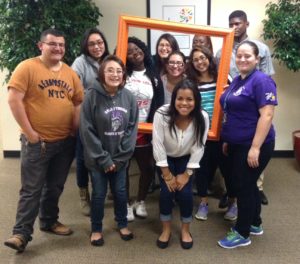 The group was just finishing up a meal of chicken strips and ham sandwiches when I arrived. There were eleven students in all. They came from various local high schools including Waco High, University, Robinson, some of the charter schools and maybe some other schools I am forgetting.
The group was just finishing up a meal of chicken strips and ham sandwiches when I arrived. There were eleven students in all. They came from various local high schools including Waco High, University, Robinson, some of the charter schools and maybe some other schools I am forgetting.
They were chatting and laughing and teasing each other when I walked in, but, predictably I suppose, that all came to a halt as soon as I actually wanted them to talk. I had to do some prodding and poking to get them to speak up and to stretch their short answers to my questions into longer ones. In the end, though, they gave me plenty to think about.
“What is poverty?” I asked. Once we had agreed on a definition, I gave them a short spiel on the government’s definition. I had them draw pie charts guessing what percentage of people in Waco had incomes below the poverty guideline. Their guesses were pretty close to the real amount – 30%. I followed with, “What are some of the bad things that can happen to a person when his/her family doesn’t have enough money?”
Eventually I asked, “If you and your family have enough money, is it important to care about families who do not have enough money? Why and why not?” Most of the students immediately said, yes, we should care. I played the devil’s advocate with them. “I work hard. I earn enough to support my family. Why should I worry about someone else’s family?”
This is the part of the conversation that I keep returning to in my mind. I really liked what they had to say. I don’t think they were trying to be especially profound. They were just saying what they thought, the first things that came into their minds. Maybe that is why their comments struck a chord in me. I’m afraid I can’t quote them exactly word for word, but I think this is a pretty fair representation of their ideas:
One girl focused on education. “What if the person who would have discovered the cure for cancer is living in South Waco right now?” She asked. “What if because her family doesn’t have the money they need, she is not getting a good enough education? Then we won’t get the cure for cancer as soon as we could.”
Another student explained the financial practicalities of caring about those with no or low income. “If you have money, it costs you money in taxes to pay the benefits to people who don’t have enough money. If they could be making enough money on their own, you wouldn’t have to pay that money. So we need to help them be able to make more money.”
One of the boys said simply, “Everybody needs some help sometimes. You should care because you might have enough now, but you might need some help sometime. ”
According to the Texas Education Agency 2013 snapshot information, 87% of WISD students are considered economically disadvantaged. It occurs to me that, based on that figure, the ideas we were discussing were pretty real for these students. They had probably experienced poverty and low-income at close range, either first hand in their own families or from observing the lives of their friends and classmates.
It also occurs to me that these young people are not children. Several of them are in JROTC. In the next year or two, they could be starting careers in one of our armed services. Some of them are taking dual credit courses at TSTC or MCC. They are making decisions right now that will affect the incomes they earn for the rest of their lives. All of them will be old enough to vote in a year or two. They are already taking on adult responsibilities and will be taking on more very soon.
Our discussion about poverty and these follow-on thoughts leave me with mixed feelings. I feel encouraged and impressed with what the students had to say. I feel thankful for programs like “Pathways to Success” that provide a place where young people are challenged to think about serious issues.
At the same time, I feel concerned. Are our young people having enough of these kinds of conversations? Are they learning how to clarify and articulate their thoughts about important, complicated social problems? Do they know how to look at both sides of an issue and how to separate fact from opinion? We had a good first conversation, but I feel like they need more practice. They need more coaching on this kind of citizen-work. They need to develop their citizen-skills and citizen-muscles. I worry that they are not getting enough of that kind of exercise.
Also, I feel a little wistful. Their answers were simple. I envy that. At what point in our lives does the issue of poverty get so complicated and controversial? When is it that we lose sight of the idea that we need to make sure the kid in South Waco is getting a good education, because she might be the one who could find a cure for cancer? When do we stop understanding that if we don’t help people earn more money, it will end up costing us more in the end? When do we forget that everybody needs help sometimes?
 This Act Locally Waco blog post is by Ashley Bean Thornton, the Manager of the www.www.actlocallywaco.org website and the editor of the Friday Update newsletter. The Act Locally Waco blog publishes posts with a connection to these aspirations for Waco. If you are interested in writing for the Act Locally Waco Blog, please email [email protected] for more information.
This Act Locally Waco blog post is by Ashley Bean Thornton, the Manager of the www.www.actlocallywaco.org website and the editor of the Friday Update newsletter. The Act Locally Waco blog publishes posts with a connection to these aspirations for Waco. If you are interested in writing for the Act Locally Waco Blog, please email [email protected] for more information.
“Pathways to Success” is a program of V.O.I.C.E. a local non-profit that works with young people and their families. The Pathways program focuses on leadership development for students in high school. Any high school student is eligible if they meet the following requirements: maintain a B average in all classes, abstain from tobacco, drugs and, alcohol, and commit to volunteer a minimum of 46 hours of community service throughout their time in the program. The 2014-2015 Pathways group is already set, but VOICE will begin taking applications for the 2015-2016 group in mid to late summer. If you are interested in learning more about Pathways or VOICE please call 254.741-9222 or email Cheryl Allen at [email protected].
